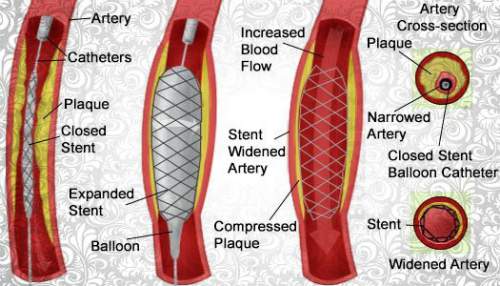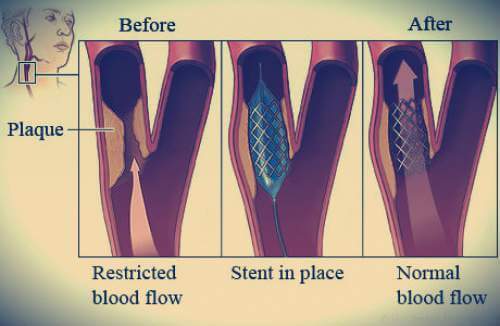Angioplasty is derived from Greek word “aggayyon” which means cavity and “plasso” mould or form. Angioplasty was first elaborated by US radiologist Dr. Charles Dotter in the year 1964. Since then, this surgical technique with some modification and innovation has been into practice.

What is angioplasty?
Angioplasty is a technique used to eliminate or remove blockages in coronary arteries (related to heart). It is also referred as percutaneous transluminal coronary angioplasty (PTCA) or percutaneous coronary intervention (PCI).
Before surgery, doctor will ask you to go for blood test and routine health check-up. Since, angioplasty makes use of iodine based dye, check if you have iodine allergy. You will also be required to quit smoking for few days before and after surgery. Consult with doctor if you are taking blood thinners like warfarin. Patients who are taking insulin injections might need to alter their dose.
Patients suffering from atherosclerosis may need to undergo angioplasty. When plaque gets build up in blood stream, it obstructs blood flow resulting in condition called atherosclerosis. Plaque is usually caused due to factors such as high blood pressure, high cholesterol and smoking habit.
Treatment for angioplasty:
Angiogram has to be first performed, before patient undergoes angioplasty. Angiogram is nothing but x-ray test which makes use of iodine dye and fluoroscopy to get precise and clear images of blood flow in arteries and veins.
Arteries are blood vessels that supply pure blood or oxygenated blood from heart to different parts of body whereas veins are blood vessels that bring impure blood or de-oxygenated blood from different parts of body to heart for purification. Aorta is major coronary artery and vena ceva is major coronary vein.
A thin tube called as catheter is inserted into the patients body via a small incision made on groin or arm. Catheter consists of a small balloon and stent (small wire tube). It is then guided to the area that is to be examined. Iodine dye is injected into the blood vessel to get clearer view of arteries on the x-ray images. These images enable doctor to know where exactly is the blockage and how narrow is the artery. Once, the site of blockage is detected, balloon is inflated and stent is pushed against the artery wall to remove plaque and blockage.
Whole procedure of angioplasty usually takes half an hour to complete. Sometimes, it may even last for several hours depending upon number of blockages. Patient is administered local anesthesia during the procedure and can go home within a day or two post surgery.
There may be some possible complications of this surgery. Bleeding or bruising of artery are common complications. Less than 1% of patients suffer fatal complications. Diabetes and kidney disorder patients may face some complications due to the use of iodine contrast dye used in angioplasty.

Types of angioplasty:
There are several types of angioplasty. Doctor may use combination of two or more types of angioplasty to clear blockages. Some common types of angioplasty are enlisted below:
- Excimer laser angioplasty: Excimer laser angioplasty is newly introduced type of angioplasty and uses optic fiber catheter. As the name suggests, it makes use of laser beam to treat blockages. Though laser system was initially developed to study atmospheric conditions, it is now a dominant system to treat coronary ailments. Hot laser beam poses threat for coronary arteries and other soft tissues. Hence, excimer a type of cool laser is used in this angioplasty. It makes use of ultraviolet light energy and is operated at 65 degree Celsius- temperature human tissue can tolerate.
- Directional atherectomy: Directional atherectomy angioplasty makes use of miniature rotating blades to cut down fat deposits in arteries.
- Rotational atherectomy: This type of angioplasty makes use of diamond studded drill bits to clear blockages. It is a bit expensive treatment as compared to other treatments.
- Intra-coronary radiation: Intra-coronary radiation is an effective technique that reduces chances of re-narrowing of artery by almost 70%. It is used in combination with balloon angioplasty.
- Post surgery recovery tips
Patient can resume his daily activities after few days of surgery. One should avoid doing heavy cardio exercises or strenuous physical activity for at least a week or two after surgery. Gradually, you can increase intensity and endurance. Avoid lifting heavy objects. Regular follow-up must be done to keep blockages in check. One must strictly follow medications prescribed by doctor. Taking adequate rest and following a healthy diet can enhance speed of recovery post surgery.
What are the benefits of angioplasty?
- Angioplasty increases chances of survival by one-third times more than other blockage treatments like thrombolysis
- It reduces chances of heart-attack
- Relieves pain
- Makes you active
- You can carry on daily routine with ease sans any pain
Cost of angioplasty in India
Prices of common medical services have dipped as per recent survey. Prices differ according to cities and hospitals. Private hospitals will charge high fees as compared to government hospitals. Average price of angioplasty in India ranges from one lac to three-four lacs. To know more about cost of angioplasty in India, click here.
